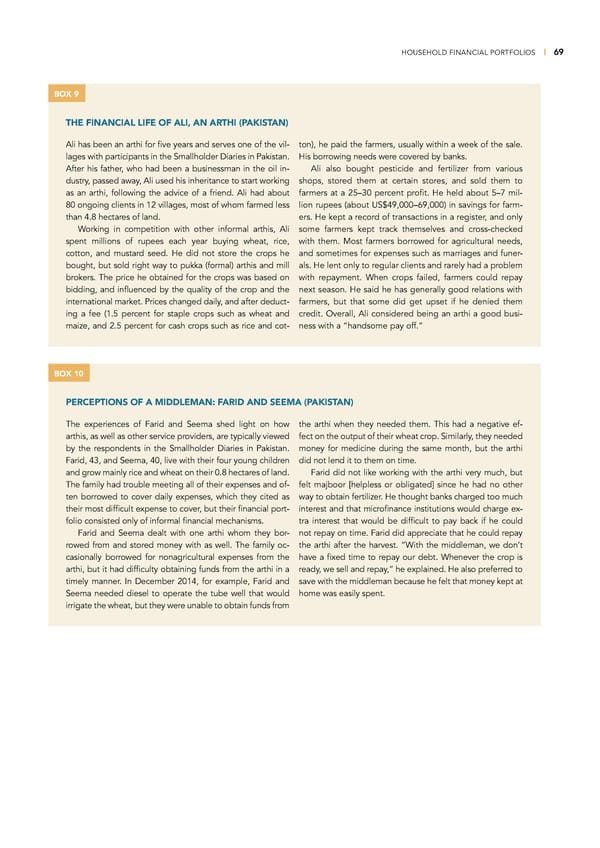HOUSEHOLD FINANCIAL PORTFOLIOS | 69 BOX 9 THE FINANCIAL LIFE OF ALI, AN ARTHI (PAKISTAN) Ali has been an arthi for five years and serves one of the vil- ton), he paid the farmers, usually within a week of the sale. lages with participants in the Smallholder Diaries in Pakistan. His borrowing needs were covered by banks. After his father, who had been a businessman in the oil in- Ali also bought pesticide and fertilizer from various dustry, passed away, Ali used his inheritance to start working shops, stored them at certain stores, and sold them to as an arthi, following the advice of a friend. Ali had about farmers at a 25–30 percent profit. He held about 5–7 mil- 80 ongoing clients in 12 villages, most of whom farmed less lion rupees (about US$49,000–69,000) in savings for farm- than 4.8 hectares of land. ers. He kept a record of transactions in a register, and only Working in competition with other informal arthis, Ali some farmers kept track themselves and cross-checked spent millions of rupees each year buying wheat, rice, with them. Most farmers borrowed for agricultural needs, cotton, and mustard seed. He did not store the crops he and sometimes for expenses such as marriages and funer- bought, but sold right way to pukka (formal) arthis and mill als. He lent only to regular clients and rarely had a problem brokers. The price he obtained for the crops was based on with repayment. When crops failed, farmers could repay bidding, and influenced by the quality of the crop and the next season. He said he has generally good relations with international market. Prices changed daily, and after deduct- farmers, but that some did get upset if he denied them ing a fee (1.5 percent for staple crops such as wheat and credit. Overall, Ali considered being an arthi a good busi- maize, and 2.5 percent for cash crops such as rice and cot- ness with a “handsome pay off.” BOX 10 PERCEPTIONS OF A MIDDLEMAN: FARID AND SEEMA (PAKISTAN) The experiences of Farid and Seema shed light on how the arthi when they needed them. This had a negative ef- arthis, as well as other service providers, are typically viewed fect on the output of their wheat crop. Similarly, they needed by the respondents in the Smallholder Diaries in Pakistan. money for medicine during the same month, but the arthi Farid, 43, and Seema, 40, live with their four young children did not lend it to them on time. and grow mainly rice and wheat on their 0.8 hectares of land. Farid did not like working with the arthi very much, but The family had trouble meeting all of their expenses and of- felt majboor [helpless or obligated] since he had no other ten borrowed to cover daily expenses, which they cited as way to obtain fertilizer. He thought banks charged too much their most difficult expense to cover, but their financial port- interest and that microfinance institutions would charge ex- folio consisted only of informal financial mechanisms. tra interest that would be difficult to pay back if he could Farid and Seema dealt with one arthi whom they bor- not repay on time. Farid did appreciate that he could repay rowed from and stored money with as well. The family oc- the arthi after the harvest. “With the middleman, we don’t casionally borrowed for nonagricultural expenses from the have a fixed time to repay our debt. Whenever the crop is arthi, but it had difficulty obtaining funds from the arthi in a ready, we sell and repay,” he explained. He also preferred to timely manner. In December 2014, for example, Farid and save with the middleman because he felt that money kept at Seema needed diesel to operate the tube well that would home was easily spent. irrigate the wheat, but they were unable to obtain funds from
 Financial Diaries with Smallholder Families Page 85 Page 87
Financial Diaries with Smallholder Families Page 85 Page 87